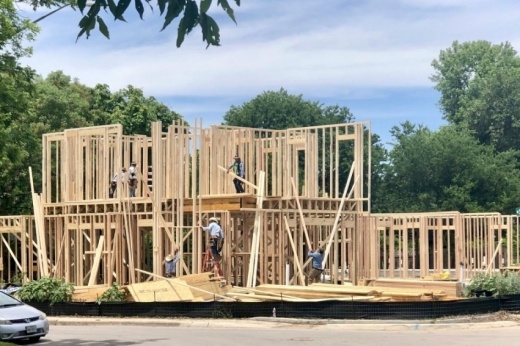The study examined how Austin's development fees stack up against other Central Texas municipalities and large cities statewide, and was released this month by the Austin Board of Realtors and the Home Builders Association of Greater Austin. Information was pulled from the ABoR's home listings database as well as a June report from the Texas Real Estate Research Center at Texas A&M University.
Bringing new single-family housing to Austin is uniquely expensive, the analysis found, due to some of the costs the city imposes on developers here. Costs referenced in the study include street impact and parkland dedication fees as well as charges related to zoning and site planning.
"Austin is one of the most expensive cities to build new homes in Texas, with fees that are drastically higher than most other cities throughout Central Texas and major metro areas across the state. That’s a problem, considering we’re in the middle of a housing supply crisis," ABoR CEO Emily Chenevert and HBAGA CEO Taylor Jackson wrote in the report.
The difference between Austin and its Texas peers is notable, both for cheaper "suburban-style" development with dozens of homes and infill development on smaller lots. For a project containing 200 homes, developers in Austin can expect to pay more than $18,000 per unit, while homebuilders in Dallas, Houston, San Antonio and Fort Worth pay between $4,841-$11,830.
The disparity is even more striking when accounting for infill projects. For developers looking to build just a few homes on a smaller property, Austin's per-unit fees of more than $41,300 are anywhere from 2.72-8.24 times as high as those elsewhere in the state. The outlook is similar when comparing Austin to its Central Texas neighbors. Although the whole region remains in the midst of an ongoing population and housing boom, almost nowhere else imposes fees as costly as Austin's.
Liberty Hill is an exception, researchers found, with per-unit development fees for "suburban-style" projects eclipsing Austin's by several thousand dollars. However, fees for infill development in Liberty Hill—while higher than anywhere in the region outside of Austin—are still just under half of those in the capital city. Many developers say the time and money required to navigate the city's permitting and development process have contributed to costlier housing—and the loss of potential projects altogether.
One example of rising expenses is the city's rapid hiking of parkland dedication fees required for new residential projects. Depending on the density of a proposed project, developers in fiscal year 2016-17 were required to pay anywhere from around $940-$1,550 for city parkland acquisition. Those fees steadily rose through FY 2020-21 when they settled between around $1,540-$2,535.
For fiscal year 2021-22, Austin more than doubled its fees to a range of around $3,440-$5,660. And the city is poised to double them once again, with a proposed $7,030-$11,570 fee range set to take effect in October. According to the new ABoR-HBAGA analysis, dedication fees—including those for parkland—take up a larger share of costs in Austin than similar fees in most other places covered in the review, especially for "suburban-style" projects.
Housing costs on the rise
As developers pay more to bring housing to town, residents are also seeing the cost of living continue to spike.
ABoR tracked home sales prices in Austin hitting record highs as of earlier in the spring, while information from https://apartmentdata.com shows local rents steadily rising for nearly two straight years.
From May 2021-May 2022, the last month with available ABoR statistics, the median Austin home price climbed 17.74% to $667,000. And from June 2021-June 2022, effective rent in the city jumped 15.57% to around $1,650 per month. Researchers noted that the high housing costs continue to keep the homebuying experience out of reach for many residents. Analysts noted that, even as of a few years ago, an average renter in the city could not afford to take out a loan for a home listed anywhere near the Austin area's median sales price.





